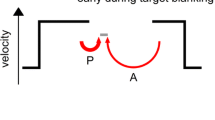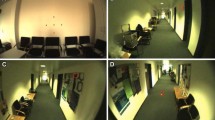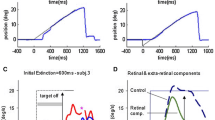Abstract
Smooth-pursuit eye-tracking performance was examined in 100 schizophrenic patients and various control groups under both attention-enhancing and attentiondistracting conditions. The level of attentional demand was varied by introducing a secondary reaction time task that directed attention either toward or away from the visual-tracking target. Distraction from the target led to a significant deterioration of tracking performance in all subjects, which was most pronounced in the group of schizophrenic patients. Attention-enhancement, on the other hand, did not normalize performance in this group. In schizophrenic patients, mainly in the distraction condition, there was a moderate association between performance in tracking and tests presumably measuring prefrontal functions. Tracking accuracy from both conditions was related to general motor performance as measured by the Neurological Evaluation Scale. It was concluded that in schizophrenic patients attentional factors (distraction) may contribute to eye-tracking impairment, and that the impairment may be viewed as an aspect of general motor dysfunctions.
Similar content being viewed by others
References
Aber LA, Ziegler A (1988) Smooth pursuit eye movements in schizophrenics: What constitutes quantitative assessment? Biol Psychiatry 24:747–761
Acker W, Toone B (1978) Attention, eye tracking and schizophrenia. Br J Soc Psychol 17:173–181
Amador XF, Sackeim HA, Mukherjee S, Halperin R, Neeley P, Maclin E, Schnur D (1991) Specificity of smooth pursuit eye movement and visual fixation abnormalities in schizophrenia: comparison to mania and normal controls. Schiz Res 5:135–144
American Psychiatric Association (1987) Diagnostic and statistical, manual of mental disorders (DSM-III-R), 3rd edn, revised. American Psychiatric Association, Washington DC
Andreasen NC, Olson S (1983) Negative v positive schizophrenia. Definition and validation. Arch Gen Psychiatry 39:789–794
Bartfai A, Levander SE, Nybäck H, Berggren B, Schalling D (1985) Smooth pursuit eye tracking, neuropsychological test performance, and computed tomography in schizophrenia. Psychiatry Res 15:49–62
Buchanan RW, Heinrichs DW (1989) The neurological evaluation scale (NES): A structured instrument for the assessment of neurological signs in schizophrenia. Psychiatry Res 27:335–350
Campion D, Thibaut F, Denise P, Pottier M, Levillain D (1992) SPEM impairment in drug-naive schizophrenic patients: evidence for a trait marker. Biol Psychiatry 32:891–902
Clementz BA, Sweeney JA (1990) Is eye movement dysfunction a biological marker for schizophrenia? A methodological review. Psychol Bull 108:77–92
Clementz BA, Sweeney JA, Hirt M, Haas G (1990) Pursuit gain and saccadic intrusions in first-degree relatives of probands with schizophrenia. J Abnorm Psychol 99:327–335
Clementz BA, Sweeney JA, Hirt M, Haas G (1991) Phenotypic correlations between oculomotor functioning and schizophrenia-related characteristics in relatives of schizophrenic probands. Psychophysiology 28:570–578
Corblatt BA, Keilp JG (1994) Impaired attention, genetics, and the pathophysiology of schizophrenia. Schiz Bull 20:31–46
Feil KJ, Iacono WG (1993) Chronic alcoholism unlikely to affect smooth pursuit eye movements in schizophrenia. Schiz Res 9: 155 (abstract)
Fukushima J, Fukushima K, Chiba T, Tanaka S, Yamashita I, Kato M (1988) Disturbances of voluntary control of saccadic eye movements in schizophrenic patients. Biol Psychiatry 23:670–677
Fukushima J, Fukushima K, Morita N, Yamashita I (1990) Further analyses of the control of voluntary saccadic eye movements in schizophrenic patients. Biol Psychiatry 28:943–958
Guitton D, Buchtel HA, Douglas RM (1985) Frontal lobe lesions in man cause difficulties in suppressing reflexive glances and in generating goal-directed saccades. Exp Brain Res 58:455–472
Heinrichs DW, Buchanan RW (1988) Significance and meaning of neurological signs in schizophrenia. Am J Psychiatry 145:11–18
Holzman PS (1987) Recent studies of psychophysiology in schizophrenia. Schiz Bull 13:49–75
Holzman PS, Proctor LR, Levy DL, Yasillo NJ, Meltzer HY, Hurt SW (1974) Eye tracking dysfunction in schizophrenic patients and their relatives. Arch Gen Psychiatry 31:143–151
Holzman PS, Levy DL, Proctor LR (1976) Smooth pursuit eye movements, attention, and schizophrenia. Arch Gen Psychiatry 33:1415–1420
Holzmann PS, Solomon CM, Levin S, Waternaux CS (1984) Smooth pursuit eye movement dysfunctions in schizophrenia: family evidence for specificity. Arch Gen Psychiatry 41:136–139
Iacono WG, Lykken DT (1979) Electro-oculographic recording and scoring of smooth pursuit on saccadic eye tracking: a parametric study using monozygotic twins. Psychophysiology 16:94–107
Iacono WG, Tuason VB, Johnson RA (1981) Dissociation of smooth-pursuit and saccadic eye tracking in remitted schizophrenics. An ocular reaction time task that schizophrenics perform well. Arch Gen Psychiatry 38:991–996
Iacono WG, Moreau M, Beiser M, Fleming JAE, and Lin T (1992) Smooth-pursuit eye tracking in first-episode psychotic patients and their relatives. J Abnorm Psychol 101:104–116
Katsanis J, Iacono WG (1991) Clinical, neuropsychological, and brain structural correlates of smooth-pursuit eye tracking performance in chronic schizophrenia. J Abnorm Psychol 100:526–534
Kay SR, Fiszbein A, Opler LA (1987) The positive and negative syndrome scale (PANSS) for schizophrenia. Schiz Bull 13:261–276
Kobatake K, Yoshii F, Shinohara Y, Nomura K, Takagi S (1983) Impairment of smooth pursuit eye movement in chronic alcoholics. Eur Neurol 22:392–396
Latham C, Holzman PH, Manschreck TC, Tole J (1981) Optokinetic nystagmus and pursuit eye movements in schizophrenia. Arch Gen Psychiatry 38:997–1001
Levin S, Jones AJ, Stark L, Merrin EL, Holzman PS (1982) Identification of abnormal patterns in eye movements of schizophrenic patients. Arch Gen Psychiatry 39:1125–1130
Levy DL, Lipton RB, Holzman PS, Davis JM (1983) Eye tracking dysfunction is unrelated to clinical state and treatment with haloperidol. Biol Psychiatry 18:813–819
Levy DL, Lipton RB, Yasillo NJ, Peterson J, Pandey G, Davis JM (1984) Psychotropic drug effects on smooth pursuit eye movements: a summary of recent findings. In: Gale A, Johnson F (eds) Theoretical and applied aspects of eye movement research. Elsevier, Amsterdam, pp 497–505
Levy DL, Holzman PS, Matthysee S, Mendell NR (1993): Eye tracking Dysfunction and schizophrenia: a critical perspective. Schiz Bull 19:461–536
Levy DL (1994) Eye tracking and schizophrenia. Schiz Bull 20:47–62
Lukoff D, Nuechterlein KH, Ventura J (1986) Manual for the expanded brief psychiatric rating scale (BPRS). Schiz Bull 12:594–602
Mather JA (1985) Eye movements of teenage children of schizophrenics: a possible inherited marker of susceptibility to the disease. J Psychiatr Res 19:523–532
Manschreck TC (1986) Motor abnormalities in schizophrenia. In: Nasrallah HA, Weinberger DR, (eds) Handbook of schizophrenia, vol 1. The neurology of schizophrenia. Elsevier, Amsterdam
Meehl PE (1990) Toward an integrated theory of schizotaxia, schizotypy, and schizophrenia. J Pers Disord 4:1–99
Mialet JP, Pichot P (1981) Eye tracking patterns in schizophrenia: an analysis based on incidence of saccades. Arch Gen Psychiatry 38:183–186
Milner B (1963) Effects of different brain lesions on card sorting. Arch Neurol 9:100–110
Nelson HE (1976) A modified card sorting test sensitive to frontal lobe defects. Cortex 12:601–614
Nuechterlein KH, Dawson ME (1984) Information Processing and attentional functioning in the developmental course of schizophrenic disorders. Schiz Bull 10:160–203
Paus T (1991) Two modes of central gaze fixation maintenance and oculomotor distractibility in schizophrenic patients. Schiz Res 5:142–152
Petrides M, Milner B (1982) Deficits on subject-ordered tasks after frontal and temporal lobe lesions in man. Neuropsychologia 20:249–262
Radant AD, Hommer DW (1992) A quantitative analysis of saccades and smooth pursuit during visual pursuit tracking. Schiz Res 6:225–235
Rea MM, Sweeney JA, Solomon CM, Walsh V, Frances A (1989) Changes in eye tracking during clinical stabilization in schizophrenia. Psychiatry Res 28:31–39
Research Branch (1975) Abnormal involuntary movement scale. Psychopharmacology 44:907–912
Röhrenbach C, Cohen E, Matthes CG von (1991) Kognitives Planungsdefizit und Negativsymptomatik bei Patienten mit erworbenen Hirnschädigungen. Z Neuropsychologie 2:83–90
Ross DE, Ochs AL, Hill MR, Goldberg SC, Pandurangi AK, Winfrey CJ (1988) Erratic eye tracking in schizophrenic patients as revealed by high-resolution techniques. Biol Psychiatry 24:675–688
Schooler NR, Kane JM (1982) Research diagnoses for tardive dyskinesia. Arch Gen Psychiatry 39:486–487
Shagass C, Amadeo M, Overton DA (1974) Eye tracking performance in psychiatric patients. Biol Psychiatry 9:245–260
Shagass C, Roemer RA, Amadeo M (1976) Eye tracking performance and engagement of attention. Arch Gen Psychiatry 33:121–125
Shallice T (1982) Specific impairments on planning. Philos Trans R Soc Lond B298:199–209
Siegel C, Waldo M, Miznor G, Adler LE, Freedman R (1984) Deficits in sensory gating in schizophrenic patients and their relatives. Arch Gen Psychiatry 41:607–612
Simpson GH, Angus JWS (1970) A rating scale for extrapyramidal side-effects. Acta Psychiatr Scand 212 (Suppl):11–19
Spohn HE, Coyne L, Spray J (1988) The effect of neuroloptics and tardive dyskinesia on smooth pursuit eye movements in chronic schizophrenics. Arch Gen Psychiatry 45:833–840
Weigl E (1941) On the psychology of so-called processes of abstraction. J Abnorm Soc Psychol 36:3–33
Weinberger DR, Berman KF, Zee RF (1986) Physiologic dysfunction of dorsolateral prefrontal cortex in schizophrenia. I. Regional Cerebral Blood Flow Evidence. Arch Gen Psychiatry 43:114–124
Wing JL, Cooper JE, Sartorius N (1973) The Present State Examination (PSE). Medical Research Council, Cambridge University Press
Wirtschafter JD, Weingarden AS (1988) Neurophysiology and central pathways in oculomotor control: physiology and anatomy of saccadic and pursuit eye movements. In: Johnston CW, Pirozzolo FJ (eds) Neuropsychology of eye movements. Erlbaum, Hillsdale, NJ pp 5–30
Author information
Authors and Affiliations
Rights and permissions
About this article
Cite this article
Schlenker, R., Cohen, R., Berg, P. et al. Smooth-pursuit eye movement dysfunction in schizophrenia: the role of attention and general psychomotor dysfunctions. Eur Arch Psychiatry Clin Nuerosci 244, 153–160 (1994). https://doi.org/10.1007/BF02191891
Received:
Accepted:
Issue Date:
DOI: https://doi.org/10.1007/BF02191891




